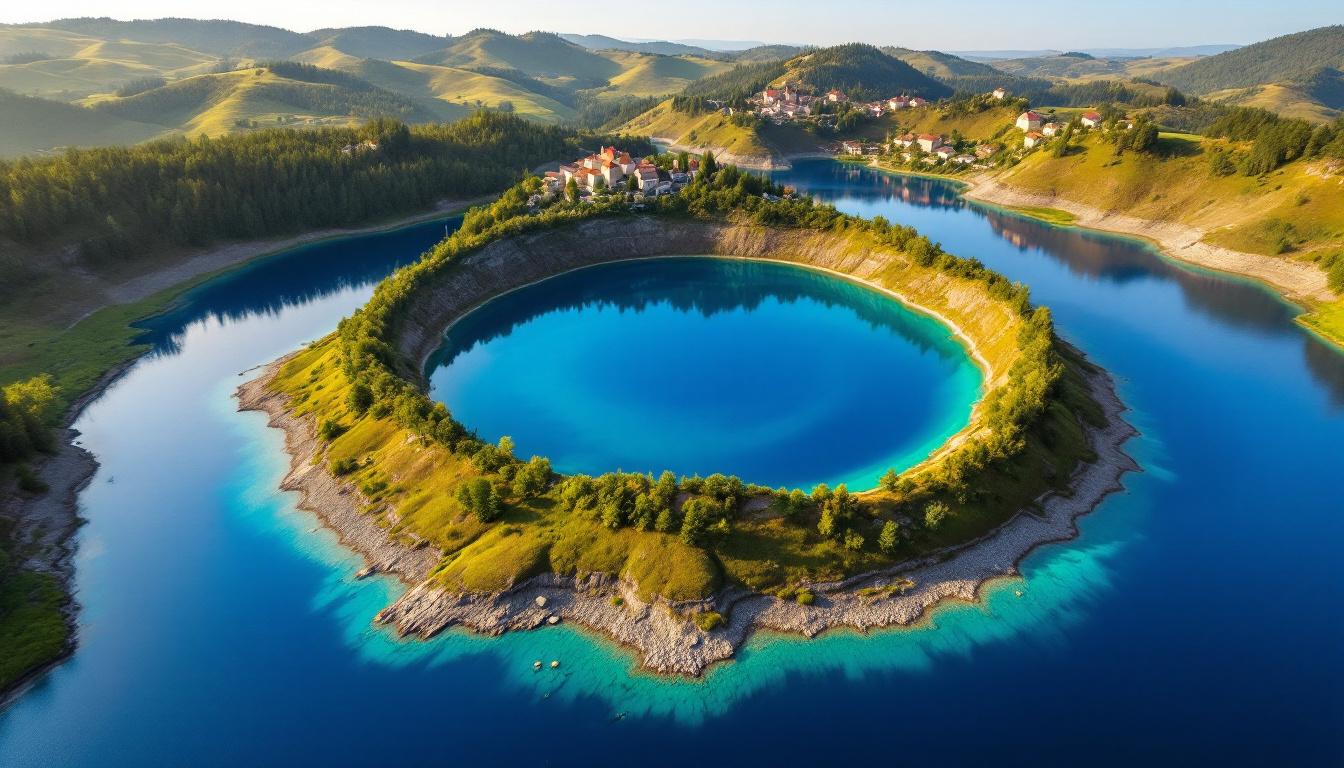Deep in France’s volcanic heart, where ancient craters hold secrets older than recorded history, Lac Pavin emerges like a sapphire dropped from heaven. This 6,900-year-old crater lake mirrors the Maldives’ ethereal blues on clear mornings, but beneath its deceptively tropical surface lies a world of methane-breathing microbes and legendary mysteries that would make any paradise island seem ordinary.
The visual deception is breathtaking. Standing on the rim at 1,197 meters elevation, you’d swear you’re gazing into a Caribbean lagoon. The midnight-blue depths reflect Auvergne’s endless skies with such clarity that tourists regularly mistake photos for tropical destinations. Yet this isn’t some warm-water paradise—it’s France’s deepest volcanic lake, where Arctic char thrive in 92-meter depths that never see sunlight.
Local shepherds in Besse-et-Saint-Anastaise have watched visitors’ faces transform from tropical expectations to geological wonder for generations. “They come expecting to swim,” laughs Marie, who runs the village fromagerie, “but leave understanding why we call it ‘pavens’—the terrible one.”
The deceptive paradise that hides volcanic secrets
Crystal waters that mirror tropical dreams
Unlike the Maldives’ shallow coral formations, Lac Pavin’s pristine clarity comes from meromictic stratification—layers that never mix. The surface sparkles with Caribbean-like transparency, while below, oxygen-starved depths harbor methane-oxidizing archaea found nowhere else in mainland France. This unique biochemistry creates an underwater world more alien than tropical.
The scientific marvel tourists never expect
What appears as paradise holds 13 million cubic meters of stratified water containing dissolved gases that occasionally erupt in dramatic displays. The 1785 “swirling gaseous column” that terrified locals wasn’t supernatural—it was CO₂ release from volcanic depths, creating phenomena that inspired centuries of local legends about drowned cities and cursed waters.
Ancient legends that explain the mysterious depths
The drowned city that science reveals
Villagers whisper of Lucifer’s tears filling this crater, but geological surveys reveal the truth behind these tales. Sedimentary shifts in the 7th and 14th centuries created underwater disturbances that locals interpreted as evidence of a sunken settlement. The “city” exists only in legend, but the volcanic activity that inspired these stories remains scientifically fascinating.
Why locals called it the terrible lake
The Latin name “pavens” meaning “terrible” originated from the lake’s unpredictable gas eruptions and inky darkness during storms. Unlike Maldivian lagoons that maintain consistent tropical hues, Pavin transforms from paradise blue to menacing black within hours, creating an emotional landscape that tropical destinations simply cannot match.
The authentic Auvergne culture behind the crater
Village life that tropical resorts cannot replicate
While Maldivian atolls offer luxury isolation, Besse-et-Saint-Anastaise provides authentic cultural immersion. Monday morning markets overflow with local Salers cheese, wild mushrooms, and volcanic honey. The 1,445 residents maintain traditions dating back centuries, offering visitors genuine French mountain culture instead of manufactured resort experiences.
Seasonal festivals that celebrate volcanic heritage
July brings the Transhumance festival, where decorated cattle parade through medieval streets before ascending to volcanic pastures. This ancient tradition connects visitors to the land’s geological story in ways no tropical resort can match. The cheese produced on these volcanic soils carries mineral complexities unknown in island paradises.
The superior alpine experience without tropical crowds
Hiking trails that reveal geological wonders
Unlike crowded Maldivian water sports, Pavin’s rim trails offer solitary communion with 6,900 years of volcanic history. The crater’s diameter spans 700-800 meters, providing perspectives that change dramatically with weather and season. Summer mornings reveal the tropical illusion, while afternoon storms showcase the lake’s darker, more mysterious character.
Photography opportunities beyond tropical clichés
Professional photographers choose Pavin over tropical destinations for its dramatic versatility. Clear mornings deliver Maldivian blues, stormy afternoons provide Nordic mystique, and winter snow creates Alpine magic around the unfrozen crater. This seasonal transformation offers visual narratives impossible in consistently tropical climates.
Lac Pavin proves that paradise doesn’t require palm trees or warm waters. This volcanic wonder delivers visual beauty rivaling any tropical destination while offering geological mysteries, authentic culture, and seasonal drama that resort islands cannot match.
Plan your French geological adventure during July for optimal hiking conditions, or explore other authentic French villages that showcase the country’s natural wonders. Discover why forgotten French destinations often surpass famous international alternatives.
Planning your volcanic crater lake adventure
When should I visit Lac Pavin for the best Maldives-like appearance?
Visit during clear summer mornings between June and September when the lake reflects bright blue skies most dramatically. Early morning light (7-9 AM) creates the strongest tropical illusion before afternoon weather changes transform the lake’s character.
How cold is the water compared to tropical destinations?
Lac Pavin remains cold year-round due to its 92-meter depth and mountain elevation. Surface temperatures rarely exceed 15°C (59°F) even in summer, making it unsuitable for tropical-style swimming but perfect for dramatic photography and geological exploration.
What makes this lake scientifically unique?
Pavin is France’s only meromictic crater lake, meaning its water layers never mix completely. This creates unique ecosystems where methane-oxidizing bacteria thrive in oxygen-free depths, producing phenomena impossible in typical lakes or ocean environments.
How far is the lake from major French cities?
Located in Auvergne-Rhône-Alpes, Lac Pavin sits approximately 450 km from Paris (4.5-hour drive) and 200 km from Lyon (2.5-hour drive). The village of Besse-et-Saint-Anastaise provides authentic accommodation and dining options.
Are there other volcanic sites nearby worth visiting?
The Chaîne des Puys volcanic range offers dozens of crater lakes, extinct volcanoes, and geological formations within 50 km. This UNESCO World Heritage site provides extensive volcanic tourism opportunities throughout the Massif Central region.
